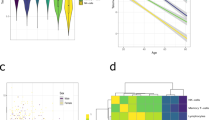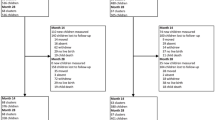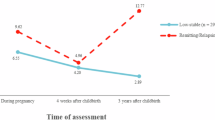Abstract
Telomere length (TL) has been associated with aging and mortality, but individual differences are also influenced by genetic factors, with previous studies reporting heritability estimates ranging from 34 to 82%. Here we investigate the heritability, mode of inheritance and the influence of parental age at birth on TL in six large, independent cohort studies with a total of 19 713 participants. The meta-analysis estimate of TL heritability was 0.70 (95% CI 0.64–0.76) and is based on a pattern of results that is highly similar for twins and other family members. We observed a stronger mother–offspring (r=0.42; P-value=3.60 × 10−61) than father–offspring correlation (r=0.33; P-value=7.01 × 10−5), and a significant positive association with paternal age at offspring birth (β=0.005; P-value=7.01 × 10−5). Interestingly, a significant and quite substantial correlation in TL between spouses (r=0.25; P-value=2.82 × 10−30) was seen, which appeared stronger in older spouse pairs (mean age ≥55 years; r=0.31; P-value=4.27 × 10−23) than in younger pairs (mean age<55 years; r=0.20; P-value=3.24 × 10−10). In summary, we find a high and very consistent heritability estimate for TL, evidence for a maternal inheritance component and a positive association with paternal age.
Similar content being viewed by others
Log in or create a free account to read this content
Gain free access to this article, as well as selected content from this journal and more on nature.com
or
References
Blackburn EH, Gall JG : A tandemly repeated sequence at the termini of the extrachromosomal ribosomal RNA genes in Tetrahymena. J Mol Biol 1978; 120: 33–53.
Blackburn EH : Switching and signaling at the telomere. Cell 2001; 106: 661–673.
Lindsey J, McGill NI, Lindsey LA, Green DK, Cooke HJ : In vivo loss of telomeric repeats with age in humans. Mutat Res 1991; 256: 45–48.
Slagboom PE, Droog S, Boomsma DI : Genetic determination of telomere size in humans: a twin study of three age groups. Am J Hum Genet 1994; 55: 876–882.
Bakaysa SL, Mucci LA, Slagboom PE et al: Telomere length predicts survival independent of genetic influences. Aging Cell 2007; 6: 769–774.
Cawthon RM, Smith KR, O'Brien E, Sivatchenko A, Kerber RA : Association between telomere length in blood and mortality in people aged 60 years or older. Lancet 2003; 361: 393–395.
Kimura M, Hjelmborg JV, Gardner JP et al: Telomere length and mortality: a study of leukocytes in elderly Danish twins. Am J Epidemiol 2008; 167: 799–806.
Njajou OT, Cawthon RM, Damcott CM et al: Telomere length is paternally inherited and is associated with parental lifespan. Proc Natl Acad Sci USA 2007; 104: 12135–12139.
Bischoff C, Petersen HC, Graakjaer J et al: No association between telomere length and survival among the elderly and oldest old. Epidemiology 2006; 17: 190–194.
Martin-Ruiz CM, Gussekloo J, van Heemst D, von Zglinicki T, Westendorp RG : Telomere length in white blood cells is not associated with morbidity or mortality in the oldest old: a population-based study. Aging Cell 2005; 4: 287–290.
Atzmon G, Cho M, Cawthon RM et al: Evolution in health and medicine Sackler colloquium: genetic variation in human telomerase is associated with telomere length in Ashkenazi centenarians. Proc Natl Acad Sci USA 2010; 107 (Suppl 1): 1710–1717.
Codd V, Mangino M, van der Harst P et al: Common variants near TERC are associated with mean telomere length. Nat Genet 2010; 42: 197–199.
Levy D, Neuhausen SL, Hunt SC et al: Genome-wide association identifies OBFC1 as a locus involved in human leukocyte telomere biology. Proc Natl Acad Sci USA 2010; 107: 9293–9298.
Mirabello L, Yu K, Kraft P et al: The association of telomere length and genetic variation in telomere biology genes. Hum Mutat 2010; 31: 1050–1058.
Rafnar T, Sulem P, Stacey SN et al: Sequence variants at the TERT-CLPTM1L locus associate with many cancer types. Nat Genet 2009; 41: 221–227.
Shen Q, Zhang Z, Yu L et al: Common variants near TERC are associated with leukocyte telomere length in the Chinese Han population. Eur J Hum Genet 2011; 19: 721–723.
Soerensen M, Thinggaard M, Nygaard M et al: Genetic variation in TERT and TERC and human leukocyte telomere length and longevity: a cross-sectional and longitudinal analysis. Aging Cell 2012; 11: 223–227.
Deelen J, Uh HW, Monajemi R et al: Gene set analysis of GWAS data for human longevity highlights the relevance of the insulin/IGF-1 signaling and telomere maintenance pathways. Age (Dordr) 2011, doi:10.1007/s11357-011-9340-3.
Bischoff C, Graakjaer J, Petersen HC et al: The heritability of telomere length among the elderly and oldest-old. Twin Res Hum Genet 2005; 8: 433–439.
Andrew T, Aviv A, Falchi M et al: Mapping genetic loci that determine leukocyte telomere length in a large sample of unselected female sibling pairs. Am J Hum Genet 2006; 78: 480–486.
Vasa-Nicotera M, Brouilette S, Mangino M et al: Mapping of a major locus that determines telomere length in humans. Am J Hum Genet 2005; 76: 147–151.
Horn T, Robertson BC, Gemmell NJ : The use of telomere length in ecology and evolutionary biology. Heredity (Edinb) 2010; 105: 497–506.
Nawrot TS, Staessen JA, Gardner JP, Aviv A : Telomere length and possible link to X chromosome. Lancet 2004; 363: 507–510.
Kimura M, Cherkas LF, Kato BS et al: Offspring’s leukocyte telomere length, paternal age, and telomere elongation in sperm. PLoS Genet 2008; 4: e37.
Nordfjall K, Larefalk A, Lindgren P, Holmberg D, Roos G : Telomere length and heredity: indications of paternal inheritance. Proc Natl Acad Sci USA 2005; 102: 16374–16378.
Nordfjall K, Svenson U, Norrback KF, Adolfsson R, Roos G : Large-scale parent-child comparison confirms a strong paternal influence on telomere length. Eur J Hum Genet 2010; 18: 385–389.
De Meyer T, Rietzschel ER, De Buyzere ML et al: Paternal age at birth is an important determinant of offspring telomere length. Hum Mol Genet 2007; 16: 3097–3102.
Unryn BM, Cook LS, Riabowol KT : Paternal age is positively linked to telomere length of children. Aging Cell 2005; 4: 97–101.
Allsopp RC, Vaziri H, Patterson C et al: Telomere length predicts replicative capacity of human fibroblasts. Proc Natl Acad Sci USA 1992; 89: 10114–10118.
Aulchenko YS, Heutink P, Mackay I et al: Linkage disequilibrium in young genetically isolated Dutch population. Eur J Hum Genet 2004; 12: 527–534.
Pardo LM, MacKay I, Oostra B, van Duijn CM, Aulchenko YS : The effect of genetic drift in a young genetically isolated population. Ann Hum Genet 2005; 69: 288–295.
Tobin MD, Tomaszewski M, Braund PS et al: Common variants in genes underlying monogenic hypertension and hypotension and blood pressure in the general population. Hypertension 2008; 51: 1658–1664.
Schoenmaker M, de Craen AJ, de Meijer PH et al: Evidence of genetic enrichment for exceptional survival using a family approach: the Leiden Longevity Study. Eur J Hum Genet 2006; 14: 79–84.
Boomsma DI, de Geus EJ, Vink JM et al: Netherlands Twin Register: from twins to twin families. Twin Res Hum Genet 2006; 9: 849–857.
Willemsen G, de Geus EJ, Bartels M et al: The Netherlands Twin Register biobank: a resource for genetic epidemiological studies. Twin Res Hum Genet 2010; 13: 231–245.
Wright MJ, Martin NG : Brisbane adolescent twin study: outline of study methods and research projects. Aust J Psychol 2004; 56: 65–78.
Medland SE, Nyholt DR, Painter JN et al: Common variants in the trichohyalin gene are associated with straight hair in Europeans. Am J Hum Genet 2009; 85: 750–755.
Moayyeri A, Hammond CJ, Valdes AM, Spector TD : Cohort Profile: TwinsUK and Healthy Ageing Twin Study. Int J Epidemiol 2012, doi:10.1093/ije/dyr207.
Cawthon RM : Telomere measurement by quantitative PCR. Nucleic Acids Res 2002; 30: e47.
R Development Core Team: R: A Language and Environment for Statistical Computing. Vienna, Austria: R foundation for Statistical Computing, 2010, 2.12.1 edn.
Pilia G, Chen WM, Scuteri A et al: Heritability of cardiovascular and personality traits in 6148 Sardinians. PLoS Genet 2006; 2: e132.
Lumley T : rmeta: Meta-analysis 2009, R package version 2.16 edn.
Mitchell JR, Wood E, Collins K : A telomerase component is defective in the human disease dyskeratosis congenita. Nature 1999; 402: 551–555.
Achi MV, Ravindranath N, Dym M : Telomere length in male germ cells is inversely correlated with telomerase activity. Biol Reprod 2000; 63: 591–598.
Eisenberg DT, Hayes MG, Kuzawa CW : Delayed paternal age of reproduction in humans is associated with longer telomeres across two generations of descendants. Proc Natl Acad Sci USA 2012; 109: 10251–10256.
Kong A, Frigge ML, Masson G et al: Rate of de novo mutations and the importance of father’s age to disease risk. Nature 2012; 488: 471–475.
Acknowledgements
ERF: The study was supported by grants from The Netherlands Organisation for Scientific Research (NWO), Erasmus MC and the Centre for Medical Systems Biology (CMSB). Telomere length assessment was supported through funds from the European Community’s Seventh Framework Programme (FP7/2007-2013), ENGAGE Consortium, grant agreement HEALTH-F4-2007-201413. We are grateful to all general practitioners for their contributions, to Petra Veraart for her help in genealogy, Jeannette Vergeer for the supervision of the laboratory work and Peter Snijders for his help in data collection. GRAPHIC: The GRAPHIC study was funded by the BHF. VC and NJS are supported by the BHF and VC, CN and NJS are supported by the Leicester National Institute of Health Research (NIHR) Biomedical Research Unit in Cardiovascular Disease. Additionally, this research was supported through funds from The European Community’s Seventh Framework Programme (FP7/2007-2013), ENGAGE Consortium, grant agreement HEALTH-F4-2007- 201413. LLS: We thank all participants of the Leiden Longevity Study. The research leading to these results has received funding from the European Union’s Seventh Framework Programme (FP7/2007-2011) under grant agreement number 259679. This study was supported by a grant from the Innovation-Oriented Research Program on Genomics (SenterNovem IGE05007), the Centre for Medical Systems Biology and the Netherlands Consortium for Healthy Ageing (grant 050-060-810), all in the framework of the Netherlands Genomics Initiative, Netherlands Organization for Scientific Research (NWO), and by Unilever Colworth. NTR: We thank all participants in the Netherlands Twin Register. Research was funded by the Netherlands Organization for Scientific Research (NWO: MagW/ZonMW grants 904-61-090, 985-10-002,904-61-193,480-04-004, 400-05-717, Addiction-31160008 Middelgroot-911-09-032, Spinozapremie 56-464-14192), Center for Medical Systems Biology (CSMB, NWO Genomics), NBIC/BioAssist/RK(2008.024), Biobanking and Biomolecular Resources Research Infrastructure (BBMRI –NL, 184.021.007), the VU University’s Institute for Health and Care Research (EMGO+), the European Community’s Seventh Framework Program (FP7/2007-2013), ENGAGE (HEALTH-F4-2007-201413) and the European Science Council (ERC–230374 and ERC-284167). QIMR: We thank Marlene Grace and Ann Eldridge for twin recruitment and data collection, Lisa Bardsley for preparation of DNA samples, David Smyth for IT/database support and the twins and their families for their participation. Data collection was supported by grants to NGM and MJW from the Australian Research Council and Australian National Health and Medical Research Council (NHMRC). Telomere length assessment was co-funded by the European Community’s Seventh Framework Programme (FP7/2007-2013), ENGAGE project, grant agreement HEALTH-F4-2007-201413 and NHMRC-European Union Collaborative Research Grant 496739. GWM and DRN were supported by the NHMRC Fellowship (619667) and ARC Future Fellowship (FT0991022) schemes, respectively. TwinsUK: The study was funded by the Wellcome Trust; European Community’s Seventh Framework Programme (FP7/2007-2013), ENGAGE project grant agreement (HEALTH-F4-2007-201413). The study also receives support from the Dept of Health via the National Institute for Health Research (NIHR) comprehensive Biomedical Research Centre award to Guy’s & St Thomas’ NHS Foundation Trust in partnership with King’s College London. TDS is an NIHR senior Investigator and is holder of an ERC Advanced Principal Investigator award. Genotyping was performed by The Wellcome Trust Sanger Institute, support of the National Eye Institute via an NIH/CIDR genotyping project.
Author information
Authors and Affiliations
Corresponding authors
Ethics declarations
Competing interests
The authors declare no conflict of interest.
Additional information
Supplementary Information accompanies this paper on European Journal of Human Genetics website
Supplementary information
Rights and permissions
About this article
Cite this article
Broer, L., Codd, V., Nyholt, D. et al. Meta-analysis of telomere length in 19 713 subjects reveals high heritability, stronger maternal inheritance and a paternal age effect. Eur J Hum Genet 21, 1163–1168 (2013). https://doi.org/10.1038/ejhg.2012.303
Received:
Revised:
Accepted:
Published:
Issue date:
DOI: https://doi.org/10.1038/ejhg.2012.303
Keywords
This article is cited by
-
Telomere Length in Patients with Gestational Diabetes Mellitus and Normoglycemic Pregnant Women: a Systematic Review and Meta-analysis
Reproductive Sciences (2024)
-
Mitochondria and telomeres: hand in glove
Biogerontology (2024)
-
Sub-optimal maternal gestational gain is associated with shorter leukocyte telomere length at birth in a predominantly Latinx cohort of newborns
Maternal Health, Neonatology and Perinatology (2023)
-
A comparison of feature selection methodologies and learning algorithms in the development of a DNA methylation-based telomere length estimator
BMC Bioinformatics (2023)
-
Bioinformatic analysis of the effect of SNPs in the pig TERT gene on the structural and functional characteristics of the enzyme to develop new genetic markers of productivity traits
BMC Genomics (2023)



